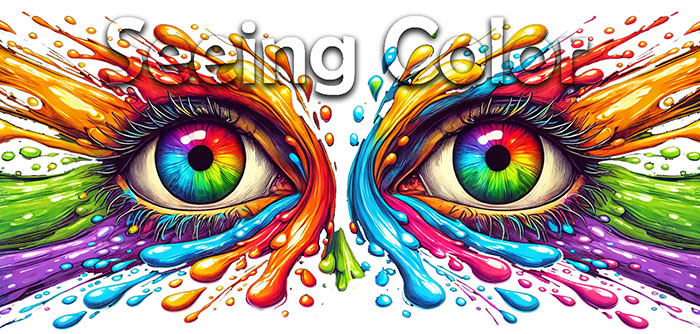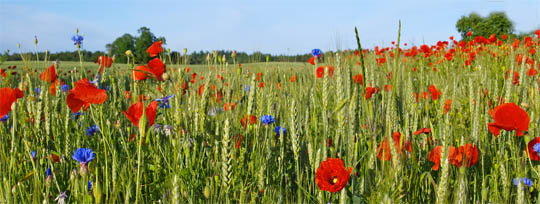
Illustrated by: Dr. Biology
How We See Color
You look out at a field of wildflowers showing off their bright reds, brilliant blues, and accents of yellow and white centers. These are just a few of the rainbow of colors you will see today, but have you ever wondered how we see these colors? What about other animals, do they see the same colors as you? Do animals see color at all?

You might not know it, but it is the light bouncing off objects like our field of flowers that gives us the ability to see. When the light enters our eyes, special cells tell our brains about the light. These cells are called photoreceptors. Light is made of little bits called photons. When the sun shines, trillions and trillions of these little bits of light fall on the earth. The photons bounce off of almost everything and some of them enter our eyes. Those bits that enter our eyes allow us to see. So, where does the color come from?
Starting in the 1600s with Sir Isaac Newton, scientists have believed that there are different kinds of photons. Different types give rise to our sense of colors. The different photons are said to have different wavelengths. Sunlight contains all the different wavelengths of photons. The visible wavelength colors can be seen when you look at a rainbow. Raindrops acting as natural prisms produce the colors.
How Do Our Photoreceptors Work?
We have two main types of photoreceptors called rods and cones. They are called rods and cones because of their shapes. These cells are located in a layer at the back of the eye called the retina. Rods are used to see in very dim light and only show the world to us in black and white.
This is why you see only black and white when you are outside in the evening or in a dimly lit room. The other type of photoreceptors, the cones, allow us to see colors. They are not as sensitive as the rods so they only work in bright light. There are three types of cones, one for each of the three main colors we see, red, green and blue. (click on the eyes above to learn more)
Some people have a genetic defect that makes one or more of the cones fail. This condition is known as color deficiency. You may have heard it called color blindness. Color blindness is fairly common, affecting about nine percent of all humans. It is much more common in men than in women. To test for color blindness a special picture called an Ishihara test is used. If you jump to our color test page you will be able to test yourself and also experience another interesting phenomenon of our color vision.
What about other animals? What kind of colors do they see? Most animals see fewer colors than we do, but some see more! We know this by looking at how many kinds of cone photoreceptors they have. Another good indication of what an animal can see is by looking at their own colors. The colors of their prey are also an indication of an animal's ability to see color. We have made a table of some common animals and what colors they see.
Read more about: Seeing Color
Bibliographic details:
- Article: Seeing Color
- Author(s): CJ Kazilek, Kim Cooper
- Publisher: Arizona State University School of Life Sciences Ask A Biologist
- Site name: ASU - Ask A Biologist
- Date published: 27 Sep, 2009
- Date accessed: 17 May, 2025
- Link: https://askabiologist.asu.edu/explore/seeing-color
APA Style
CJ Kazilek, Kim Cooper. (Sun, 09/27/2009 - 13:33). Seeing Color. ASU - Ask A Biologist. Retrieved from https://askabiologist.asu.edu/explore/seeing-color
Chicago Manual of Style
CJ Kazilek, Kim Cooper. "Seeing Color". ASU - Ask A Biologist. 27 Sep 2009. https://askabiologist.asu.edu/explore/seeing-color
MLA 2017 Style
CJ Kazilek, Kim Cooper. "Seeing Color". ASU - Ask A Biologist. 27 Sep 2009. ASU - Ask A Biologist, Web. https://askabiologist.asu.edu/explore/seeing-color

Color spectrum on the surface of a music CD.
Be Part of
Ask A Biologist
By volunteering, or simply sending us feedback on the site. Scientists, teachers, writers, illustrators, and translators are all important to the program. If you are interested in helping with the website we have a Volunteers page to get the process started.







